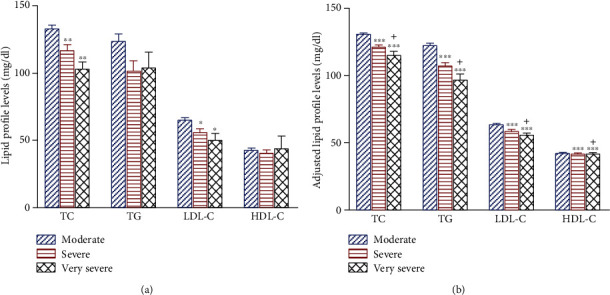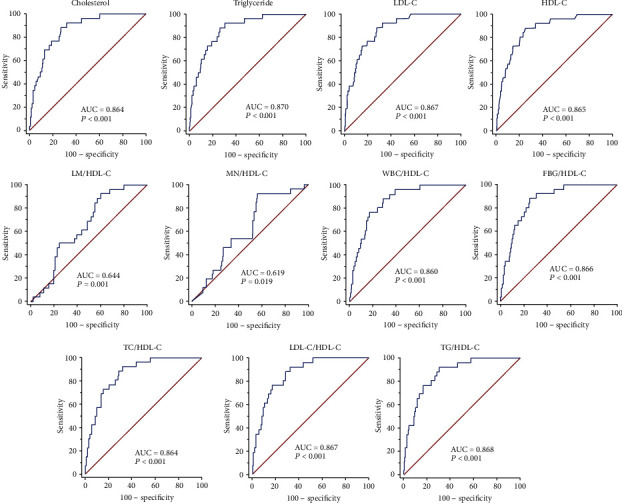血脂及其相对比值(胆固醇/HDL-C、甘油三酯/HDL-C、LDL-C/HDL-C、WBC/HDL-C和FBG/HDL-C)在入院时预测住院死亡率中的作用
IF 5.9
Q1 BIOCHEMISTRY & MOLECULAR BIOLOGY
引用次数: 5
摘要
背景:脂质谱及其相关比值,如总胆固醇(TC)、低密度脂蛋白-胆固醇(LDL-C)、甘油三酯(TG)、高密度脂蛋白-胆固醇(HDL-C)、TG/HDL-C比值、TC/HDL-C比值、LDL-C/HDL-C比值、白细胞(WBC)/HDL-C比值、空腹血糖(FBG)/HDL-C比值,是各种疾病预测死亡率的重要指标。本研究旨在探讨血脂比例在预测COVID-19患者死亡率中的作用。方法:所有患者入院时进行实验室检查(n = 300)。使用受试者工作特征(ROC)评估脂质谱比值确定COVID-19严重程度的能力。并以Kaplan-Meier曲线的平均值确定生存概率,终点为死亡。结果:死亡患者TG、TC、LDL-C、HDL-C、TC/HDL-C、TG/HDL-C、LDL-C/HDL-C参数均显著低于存活患者,而WBC/HDL-C、FBG/HDL-C均显著高于存活患者。TC (HR = 3.178, 95% ci = 1.064 ~ 9.491, P < 0.05), TG (HR = 3.276, 95% ci = 1.111 ~ 9.655, P < 0.05),低密度脂蛋白(HR = 3.207, 95% ci = 1.104 ~ 9.316, P < 0.05),高密度脂蛋白胆固醇(HR = 3.690, 95% ci = 1.290 ~ 10.554, P < 0.05),以及TC / hdl - c (HR = 3.860, 95% ci = 1.289 ~ 11.558, P < 0.05), TG /高密度脂蛋白胆固醇(HR = 3.860, 95% ci = 1.289 ~ 11.558, P < 0.05),低密度脂蛋白胆固醇/高密度脂蛋白胆固醇(HR = 3.915, 95% ci = 1.305 ~ 11.739, P < 0.05),白细胞/高密度脂蛋白胆固醇(HR = 3.232, 95% ci = 1.176 ~ 8.885, P < 0.05),与光纤光栅/高密度脂蛋白胆固醇比率(HR = 4.474,95%CI = 1.567 ~ 12.777, P < 0.01),与生存率有显著相关性。多因素Cox回归模型显示,只有FBG/HDL-C比值(HR = 5.477, 95%CI = 1.488 ~ 20.153, P < 0.01)与生存率显著相关。结论:结果提示住院COVID-19患者的FBG/HDL-C比值是预测死亡率的可靠指标。本文章由计算机程序翻译,如有差异,请以英文原文为准。



Role of Lipid Profile and Its Relative Ratios (Cholesterol/HDL-C, Triglyceride/HDL-C, LDL-C/HDL-C, WBC/HDL-C, and FBG/HDL-C) on Admission Predicts In-Hospital Mortality COVID-19.
Background Lipid profile and its related ratios such as total cholesterol (TC), low-density lipoprotein-cholesterol (LDL-C), triglyceride (TG), high-density lipoprotein-cholesterol (HDL-C), TG/HDL-C ratio, TC/HDL-C ratio, LDL-C/HDL-C ratio, white blood cell (WBC)/HDL-C ratio, and fasting blood glucose (FBG)/HDL-C ratio are valuable indicators that have been studied in various disorders to predict mortality. The present study was conducted with the aim of investigating the role of lipid profile ratios in predicting mortality in COVID-19 patients. Methods At the beginning of hospitalization, laboratory tests were taken from all patients (n = 300). The ability of lipid profile ratios to determine the COVID-19 severity was evaluated using receiver-operating characteristic (ROC). In addition, survival probability was determined with the average of Kaplan-Meier curves, so that the end point was death. Results In deceased patients, TG, TC, LDL-C, HDL-C, TC/HDL-C, TG/HDL-C, and LDL-C/HDL-C parameters were significantly lower than those of surviving patients, while WBC/HDL-C and FBG/HDL-C were significantly higher. TC (HR = 3.178, 95%CI = 1.064 to 9.491, P < 0.05), TG (HR = 3.276, 95%CI = 1.111 to 9.655, P < 0.05), LDL-C (HR = 3.207, 95%CI = 1.104 to 9.316, P < 0.05), and HDL-C (HR = 3.690, 95%CI = 1.290 to 10.554, P < 0.05), as well as TC/HDL-C (HR = 3.860, 95%CI = 1.289 to 11.558, P < 0.05), TG/HDL-C (HR = 3.860, 95%CI = 1.289 to 11.558, P < 0.05), LDL-C/HDL-C (HR = 3.915, 95%CI = 1.305 to 11.739, P < 0.05), WBC/HDL-C (HR = 3.232, 95%CI = 1.176 to 8.885, P < 0.05), and FBG/HDL-C ratios (HR = 4.474, 95%CI = 1.567 to 12.777, P < 0.01), were detectably related to survival. The multivariate Cox regression models showed that only FBG/HDL-C ratio (HR = 5.477, 95%CI = 1.488 to 20.153, P < 0.01) was significantly related to survival. Conclusion The results suggested that FBG/HDL-C ratio in hospital-admitted COVID-19 patients was a reliable predictor of mortality.
求助全文
通过发布文献求助,成功后即可免费获取论文全文。
去求助
来源期刊

Journal of Lipids
BIOCHEMISTRY & MOLECULAR BIOLOGY-
自引率
0.00%
发文量
7
审稿时长
12 weeks
期刊介绍:
Journal of Lipids is a peer-reviewed, Open Access journal that publishes original research articles and review articles related to all aspects of lipids, including their biochemistry, synthesis, function in health and disease, and nutrition. As an interdisciplinary journal, Journal of Lipids aims to provide a forum for scientists, physicians, nutritionists, and other relevant health professionals.
 求助内容:
求助内容: 应助结果提醒方式:
应助结果提醒方式:


